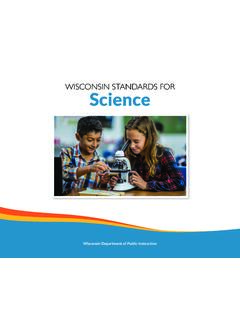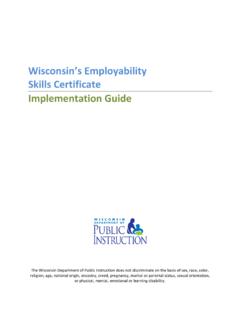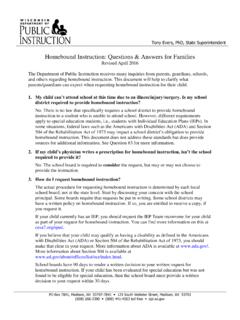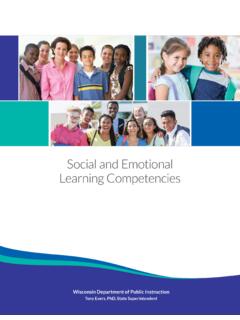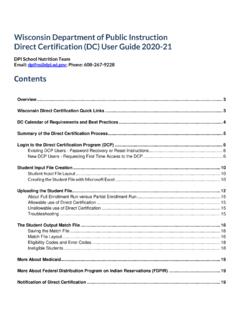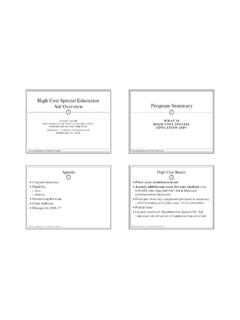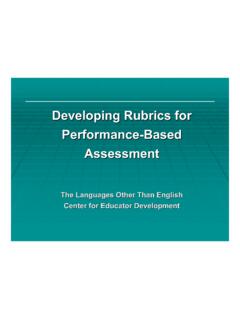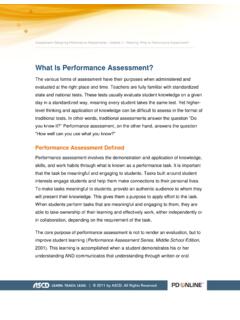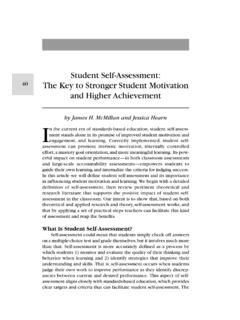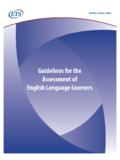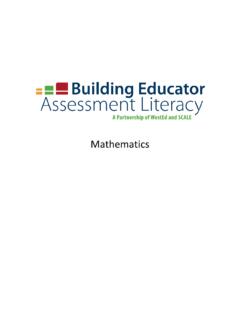Transcription of FORMATIVE ASSESSMENT: 10 Key Questions
1 1 Wisconsin Department of Public Instruction January, 2017 FORMATIVE assessment : 10 Key Questions Introduction Consider using this document as one of a variety of resources to support educators professional practice, to increase assessment literacy, and as a powerful tool to build student-teacher relationships and improve student outcomes. When considering the setting and purpose to use this document, feel free to customize it to your own needs. Possible uses in professional development: Share during a faculty meeting to surface experiences with and attitudes toward professional practice Discuss during PLC time to apply, extend, and sharpen professional practice Use with new or struggling teachers to enhance professional practice and assessment literacy Focus on one or two Questions with a team to engage in deep reflection about understanding, current practices, connection-making, areas of strength and for growth, etc.
2 What is FORMATIVE assessment ? FORMATIVE assessment is a deliberate process used by teachers and students during instruction to provide specific, actionable, and immediate feedback. They are designed to quickly inform instruction by providing specific and immediate feedback through daily, ongoing instructional strategies that are student- and classroom-centered, and that answer "what comes next for student learning?" The FORMATIVE assessment process plays a vital role within the Wisconsin Strategic assessment System. To examine how FORMATIVE assessment practices fit within a Strategic assessment System, please refer to the videos and foundational documents at Questions 1. What makes an assessment FORMATIVE ? 2. What are some examples of effective FORMATIVE assessment practices?
3 3. How is the FORMATIVE assessment process different than summative and interim assessment ? 4. What is best practice regarding FORMATIVE assessment practices, grading, and homework? 5. How can homework be used formatively? 6. How can I make sure my students are using the feedback I provide to advance their learning? 7. What if a student shows a solid understanding of the learning target within my FORMATIVE practice, but does NOT within the classroom summative assessment (chapter test, end of unit test, etc.)? 8. What are common FORMATIVE assessments ? How are they different than FORMATIVE assessment practices? 9. How much time does the FORMATIVE assessment process take? How do I find time in my schedule to use it my classroom? 10. What should I look for if I am purchasing a FORMATIVE assessment commercial product to use in my classroom?
4 *Please note that Wisconsin Department of Instruction refers to the FORMATIVE assessment process AND FORMATIVE practices (that occur within that process) but refrain from using the term FORMATIVE assessments. We avoid the word assessments because the strategic use of FORMATIVE practices to elicit feedback from students is not a test event -- but rather an instructional process. 2 Wisconsin Department of Public Instruction January, 2017 1. What makes an assessment FORMATIVE ? An assessment is FORMATIVE if the data collected is used to gauge student understanding; provides students with specific, actionable, and immediate feedback; and adjust instructional strategies in relation to the standards or learning goal.
5 The FORMATIVE assessment process involves both the teacher AND the student, answering the following Questions regarding student learning: Where am I going? Where am I now? How do I get from here to there? Within the FORMATIVE assessment process, the teacher and the student are giving and receiving feedback about the student s learning progression using a continuous dialogue in order to know what comes next for student learning. As such, FORMATIVE practices personalize the teaching and learning cycle. Feedback may occur in the form of teacher-student, student-teacher, student-student, or student-self. An essay, project, quiz, test, or informal check for understanding can serve as a FORMATIVE assessment if the data is used to adjust instructional strategies to meet the needs of students at various levels of learning.
6 However, if a teacher were to use that same assessment to report a final grade, or provide the data to the district or state, the assessment would be summative because it would be an assessment OF learning, not an assessment FOR learning. Summative assessments are meant to gauge student learning in relation to a specific set of standards, at a particular point in time. 2. What are some examples of effective FORMATIVE assessment practices? Most teachers are already using FORMATIVE assessment practices within their own classrooms. Some examples include teacher observations of student learning, student-teacher conferencing, questioning for understanding, thumbs up/thumbs down, exit and entrance tickets, students using whiteboards within the classroom, etc.
7 The key to using these strategies effectively is to use the data gathered from FORMATIVE practices to reflect on and provide high-quality feedback that guides future teaching and learning. This could include examples such as a teacher taking anecdotal notes and referencing these notes to help form learning groups; a teacher re-teaching a skill to a small number of students who did NOT show proficiency during a conference; or a teacher providing extension opportunities for students who are ready to move on to the next level of learning. The important piece to note is that in all of these examples, the teacher is using data gathered from the FORMATIVE assessment process in order to guide future instruction and to personalize student learning to close student learning gaps.
8 It s not FORMATIVE unless the teacher acts on the results by adjusting instruction and by providing feedback. 3 Wisconsin Department of Public Instruction January, 2017 In the vignettes below, each teacher is using FORMATIVE practices, ranging from Teacher A s quick check of student understanding to Teacher C s most systemized and strategic FORMATIVE practice. The FORMATIVE assessment Process: Teacher Vignettes A teacher is finishing a lesson on a new learning target and conducts a quick check for student understanding in order to plan for the next lesson.
9 She asks the class to give her a thumbs up if they are confident in their comprehension of the new material, a thumbs to the side if they have a question(s) about the new material, or a thumbs down if they do not understand the new material and need additional help from the teacher. Characteristics of Effective FORMATIVE assessment Practices Based on specific learning targets Designed by teachers Elicits evidence of student learning Informs instruction Involves students Provides specific, actionable, immediate feedback Teacher A ..After looking around the room at the students thumbs up/thumbs down, the teacher notes which students she needs conference with about misconceptions and Questions . Since the majority of the students showed a thumbs up, the teacher decides to continue with the lesson.
10 X X X X Teacher B .. The next day, she confers with the students who had a question or a misconception. The students from that group who feel confident join the thumbs up group to continue practicing. X X X X Teacher C .. Next, the teacher confers with the students who had their thumbs down, or who still had Questions to re-teach the lesson and provide guidance as necessary to ensure understanding. The next day, all students complete an entrance slip assessing the new material. The teacher rechecks student comprehension and the FORMATIVE assessment cycle continues as students needs arise. X X X X X X 4 Wisconsin Department of Public Instruction January, 2017 3.
